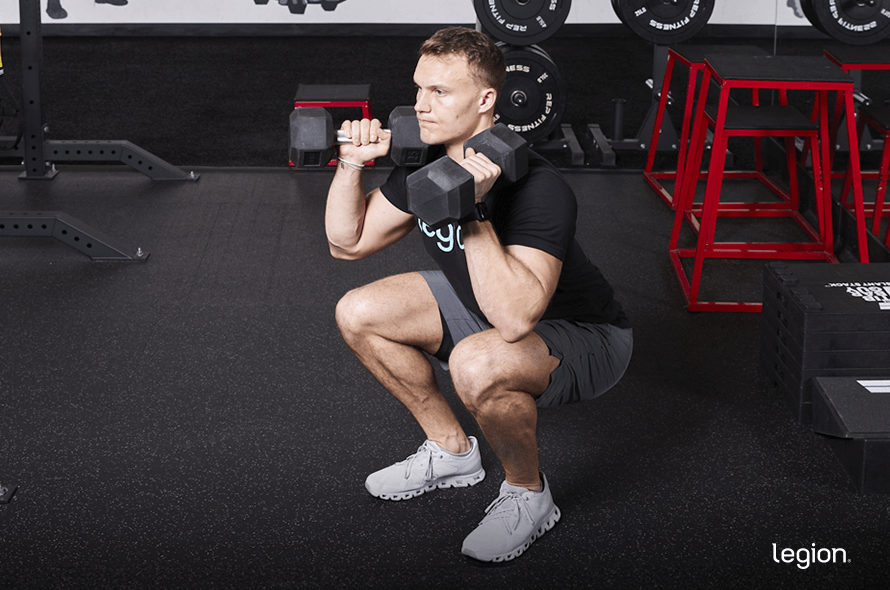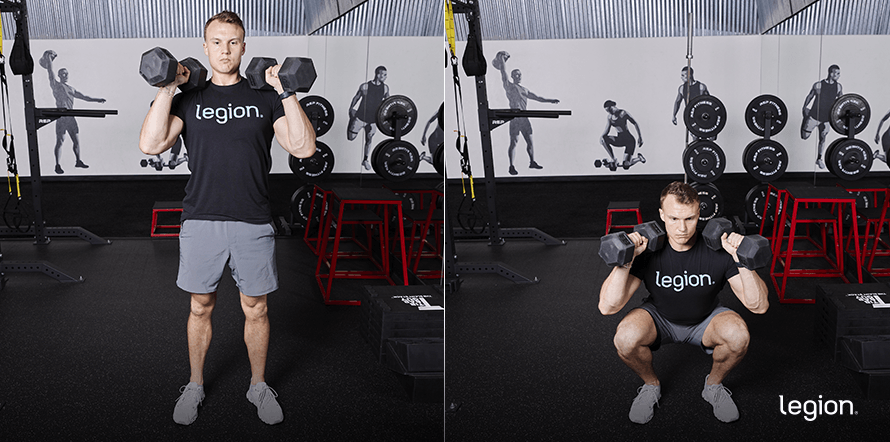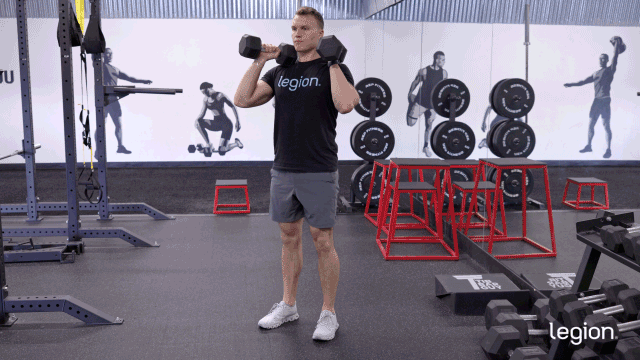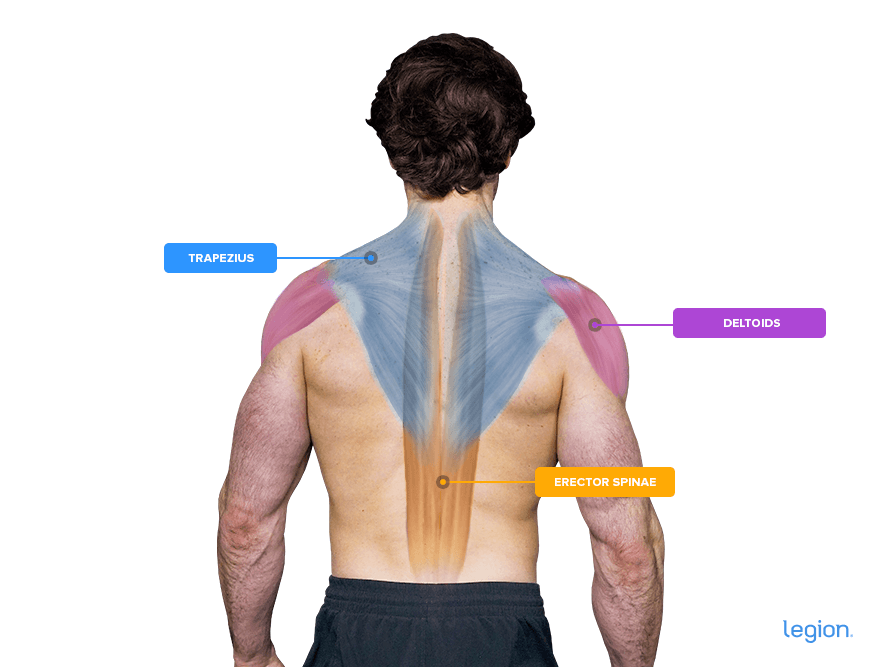The dumbbell entrance squat is difficult to beat for its simplicity and effectiveness.
With only a pair of dumbbells and a little bit of ground area, you possibly can construct muscle and power all through your complete decrease physique whereas additionally coaching main higher physique muscle mass, together with your again, shoulders, and core.
Even higher, it’s gentler in your joints than barbell squatting and straightforward to be taught, making it a super train for novices venturing into free-weight coaching.
That stated, mastering the dumbbell entrance squat requires a couple of particular kind pointers, notably when establishing the train.
On this article, you’ll be taught all the pieces you’ll want to carry out entrance squats with dumbbells safely and successfully, from setup to execution, together with the advantages, muscle mass labored, and extra.
Key Takeaways
- The dumbbell entrance squat is an easy, efficient decrease physique train that requires solely a pair of dumbbells and minimal ground area.
- It builds power in your complete decrease physique whereas additionally participating main higher physique muscle mass like your core, shoulders, and again.
- It’s gentler in your joints than barbell squats, so it’s splendid for novices, providing a secure but efficient technique to develop leg muscle and power.
- Correct kind, particularly throughout the setup, is important for safely reaping all the advantages of the dumbbell entrance squat.
- One of the best variations of the dumbbell entrance squat are the dumbbell squat, dumbbell entrance squat to press, field entrance squat with dumbbells, goblet squat, and dumbbell sumo squat.


Find out how to Do Dumbbell Entrance Squats
The best technique to learn to do dumbbell entrance squats is to separate the train into three components: arrange, descend, and squat.


1. Arrange
The trickiest a part of performing entrance squats with dumbbells in your shoulders is transferring the weights out of your sides to shoulder top—a place often known as the “dumbbell entrance rack”. You’ve received two methods to do it:
- Curl the weights: If the dumbbells are mild, carry out a hammer curl to deliver them to shoulder top.
- Clear the weights: When the dumbbells get too heavy to twist, carry out a “clear”—an explosive motion that makes use of lower-body momentum to deliver the weights as much as your shoulders.
To wash the weights to shoulder top, stand with a hip-width stance holding a dumbbell in every hand and your palms going through your thighs. Take a deep breath and brace your core such as you’re about to take a punch, then barely bend at your hips and knees as for those who’re about to leap.
Whereas maintaining your again straight and eyes ahead, explode upward by driving via your heels, utilizing the momentum to drag the dumbbells up towards your shoulders. Consider it as your legs giving a fast “pop” to ship the load upward.
Because the dumbbells attain shoulder top, place them so the ends nearest your thumbs relaxation in your shoulders, then push your elbows up and out in entrance of you to finish the entrance rack.
2. Descend
Whereas sustaining the dumbbell entrance rack place, sit straight down, pushing your knees out in the identical path as your toes.
Descend till your hip creases (the factors the place your thighs meets your pelvis) is one-to-two inches under the tops of your knees.
3. Squat
Arise and return to the beginning place. Right here’s the way it ought to look if you put all of it collectively:


Dumbbell Entrance Squat Advantages
Builds Decrease Physique Muscle
The dumbbell entrance squat trains your complete decrease physique, together with your quads, glutes, and hamstrings. It additionally engages your core, shoulders, and decrease and mid again to assist stabilize the load.
In different phrases, it’s a superb train for constructing decrease physique muscle that additionally trains a number of different main muscle teams all through the physique.
RELATED: This Is the Final Decrease Physique Exercise You’ll Ever Want
Mild on Your Knees and Decrease Again
Analysis exhibits that front-loaded squats, just like the dumbbell entrance squat, place considerably much less compressive drive in your knees and decrease again in comparison with again squats. This makes it a wise alternative for anybody with knee or again points who nonetheless desires to construct decrease physique muscle and power.
RELATED: Ought to Your Knees Go Over Your Toes When You Squat?
Appropriate for New Weightlifters
Performing the entrance squat with dumbbells requires much less method than squatting with a barbell, making it a super start line for anybody new to weightlifting. It additionally requires minimal gear, so it’s an awesome possibility for anybody beginning their health journey who prefers to coach at residence.
RELATED: The Full Newbie’s Information to Weightlifting
Muscle tissue Labored by Dumbbell Entrance Squats
The principle muscle mass labored by dumbbell entrance squats are:
- Quadriceps (quads)
- Glutes
- Hamstrings
- Erector spinae (decrease again)
- Traps
- Deltoids (delts)
- Core
Right here’s how these muscle mass look in your physique:




Dumbbell Entrance Squat Variations
1. Dumbbell Squat
The dumbbell squat is just like the entrance squat however doesn’t practice your higher physique muscle mass—like your mid again and shoulders—as successfully. Holding the dumbbells at your sides additionally places extra pressure in your grip and might really feel awkward, particularly with bulkier or heavier dumbbells.
That’s why I usually choose the dumbbell entrance squat, particularly when the weights get heavy.
READ MORE: Dumbbell Squat: Variations, Type & Advantages
2. Dumbbell Entrance Squat to Press
Whereas the dumbbell entrance squat to press is a wonderful full-body conditioning train, it’s not so good as the common dumbbell entrance squat for constructing decrease physique muscle. That’s since you’re restricted to the quantity of weight your shoulders can press, which generally isn’t heavy sufficient to tax your legs.
3. Field Entrance Squat with Dumbbells
Within the field entrance squat with dumbbells, you sit again onto a field on the backside of every rep, which retains your shins extra vertical and reduces knee stress. This makes it a superb possibility for those who’re coping with knee ache or on the lookout for a extra managed technique to practice your legs with out compromising joint well being.
4. Dumbbell Goblet Squat
There is only one main distinction between the goblet squat and the dumbbell entrance squat: within the goblet squat you maintain a single dumbbell in entrance of your chest as an alternative of resting dumbbells in your shoulders.
Whereas this makes the goblet squat simpler to arrange, it additionally makes it extra demanding in your higher again, which can restrict how a lot weight you possibly can elevate and, thus, how a lot decrease physique muscle you construct.
Because of this, the goblet squat is an effective variation to make use of as an introduction to free-weight squatting, however finally, the dumbbell entrance squat will probably be higher for gaining leg muscle and power.
READ MORE: Goblet Squat: Type, Type, Muscle tissue Labored, & Frequent Errors
5. Dumbbell Sumo Squat
The dumbbell sumo squat makes use of a large stance together with your ft turned out, which will increase glute activation and permits you to squat deeper, each of which can assist you construct your glutes. It additionally emphasizes your adductor longus, giving it an edge over common dumbbell entrance squats if internal thigh growth is a precedence.
READ MORE: Find out how to Do a Sumo Squat: Type, Advantages, and Variations
FAQ #1: Are dumbbell entrance squats efficient?
Sure, squatting with dumbbells in entrance of you is very efficient for constructing decrease physique power and muscle. It primarily trains your quads, glutes, and hamstrings, but in addition engages your core and again to stabilize the load.
Put merely, it’s a incredible train for coaching your decrease physique that additionally helps develop a number of main higher physique muscle teams.
FAQ #2: How a lot weight ought to I exploit for dumbbell entrance squats?
Performing dumbbell entrance squats within the 8-to-10 rep vary works greatest for most individuals. That’s, select a weight mild sufficient to hit no less than 8 reps per set, however heavy sufficient you can’t do greater than 10.
Lifting in a decrease rep vary with heavier weights makes establishing the train awkward, whereas lighter weights and better reps can push your cardiovascular limits earlier than your muscle mass are absolutely stimulated. In different phrases, goal for a weight that lets your muscle mass—not your lungs—dictate when the set ends.
FAQ #3: Dumbbell entrance squat vs. Goblet squat: Which is best?
Each workouts are efficient, however dumbbell entrance squats typically provide extra long-term potential for constructing decrease physique muscle and power. The goblet squat is commonly simpler to arrange and nice for novices, nevertheless it’s tougher in your higher again, which might restrict how a lot weight you possibly can elevate.
The dumbbell entrance squat means that you can deal with extra weight, making it the higher possibility for progressing your decrease physique power over time.
READ MORE: What Is Progressive Overload Coaching?
Scientific References +
- BAUTISTA, DAVID, et al. “A Comparability of Muscle Activation among the many Entrance Squat, Overhead Squat, Again Extension and Plank.” Worldwide Journal of Train Science, vol. 13, no. 1, Might 2020, p. 714, pmc.ncbi.nlm.nih.gov/articles/PMC7241624/.
- Gullett, Jonathan C, et al. “A Biomechanical Comparability of Again and Entrance Squats in Wholesome Skilled People.” Journal of Energy and Conditioning Analysis, vol. 23, no. 1, Jan. 2009, pp. 284–292, journals.lww.com/nsca-jscr/fulltext/2009/01000/A_Biomechanical_Comparison_of_Back_and_Front.41.aspx, https://doi.org/10.1519/jsc.0b013e31818546bb.
- Swinton, Paul A., et al. “A Biomechanical Comparability of the Conventional Squat, Powerlifting Squat, and Field Squat.” Journal of Energy and Conditioning Analysis, vol. 26, no. 7, July 2012, pp. 1805–1816, https://doi.org/10.1519/jsc.0b013e3182577067.
- Fry, Andrew C., et al. “Impact of Knee Place on Hip and Knee Torques throughout the Barbell Squat.” The Journal of Energy & Conditioning Analysis, vol. 17, no. 4, 1 Nov. 2003, pp. 629–633, journals.lww.com/nsca-jscr/Summary/2003/11000/Effect_of_Knee_Position_on_Hip_and_Knee_Torques.1.aspx.
- McBride, Jeffrey M, et al. “Comparability of Kinetic Variables and Muscle Exercise throughout a Squat vs. a Field Squat.” Journal of Energy and Conditioning Analysis, vol. 24, no. 12, Dec. 2010, pp. 3195–3199, https://doi.org/10.1519/jsc.0b013e3181f6399a.
- Paoli, Antonio, et al. “The Impact of Stance Width on the Electromyographical Exercise of Eight Superficial Thigh Muscle tissue throughout Again Squat with Completely different Bar Hundreds.” Journal of Energy and Conditioning Analysis, vol. 23, no. 1, Jan. 2009, pp. 246–250, https://doi.org/10.1519/jsc.0b013e3181876811.
- Larsen, Stian , et al. Results of Stance Width and Barbell Placement on Kinematics, Kinetics, and Myoelectric Exercise in Again Squats. 31 Aug. 2021, www.frontiersin.org/journals/sports-and-active-living/articles/10.3389/fspor.2021.719013/full, https://doi.org/10.3389/fspor.2021.719013.
- Lorenzetti, Silvio, et al. “Find out how to Squat? Results of Varied Stance Widths, Foot Placement Angles and Degree of Expertise on Knee, Hip and Trunk Movement and Loading.” BMC Sports activities Science, Medication and Rehabilitation, vol. 10, no. 1, 17 July 2018, bmcsportsscimedrehabil.biomedcentral.com/articles/10.1186/s13102-018-0103-7, https://doi.org/10.1186/s13102-018-0103-7.
- Kubo, Keitaro, et al. “Results of Squat Coaching with Completely different Depths on Decrease Limb Muscle Volumes.” European Journal of Utilized Physiology, vol. 119, no. 9, 22 June 2019, https://doi.org/10.1007/s00421-019-04181-y.
- Marchetti, Paulo Henrique, et al. “Muscle Activation Differs between Three Completely different Knee Joint-Angle Positions throughout a Maximal Isometric Again Squat Train.” Journal of Sports activities Medication, vol. 2016, 2016, pp. 1–6, www.ncbi.nlm.nih.gov/pmc/articles/PMC4967668/, https://doi.org/10.1155/2016/3846123. Accessed 9 Dec. 2019.
- Delmore, Robert J., et al. “Adductor Longus Activation throughout Frequent Hip Workouts.” Journal of Sport Rehabilitation, vol. 23, no. 2, Might 2014, pp. 79–87, https://doi.org/10.1123/jsr.2012-0046.










Discussion about this post